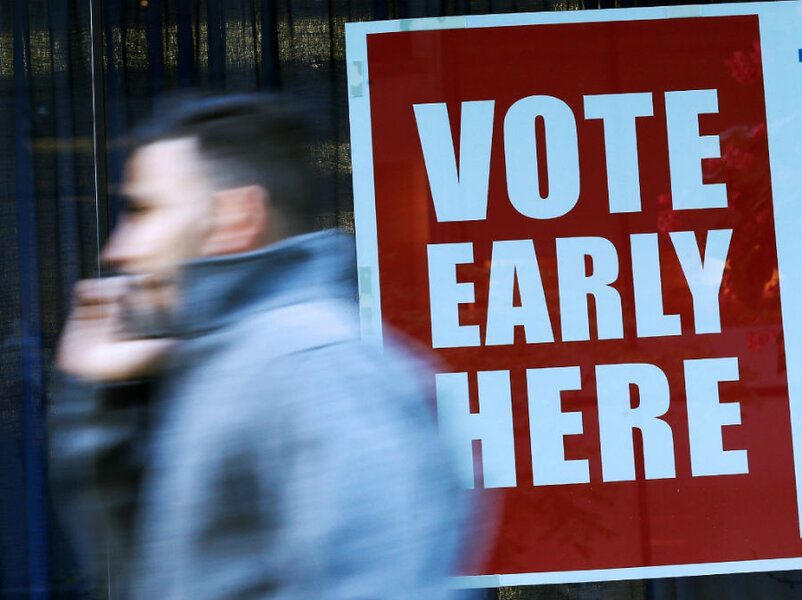1.5 million Americans have already voted: What can early ballots reveal?
Loading...
With three weeks left before election day, nearly 1.5 million voters have joined a growing part of the electorate that casts their ballots before the second Tuesday of November.
Early and absentee voting methods have become more common in recent presidential elections, and both major parties are seeking to push their supporters to the polls early – a tactic that has proved effective in winning swing states in past years. In 2000, just 16 percent of voters cast their ballots early, compared to a third of the electorate in 2012.
On Tuesday, a Politico headline stated: "Early voting reveals warning signs for Trump."
While early voting offers convenience for voters who may face barriers or time constraints a chance to cast their ballots – and party operatives have used the data to gauge how well a candidate is performing – analysts say that it not be a reliable indicator of who will win the state.
“A lot of caution has to be used when looking at early returns,” Matthew Weil, the associate director of the Democracy Project at the Bipartisan Policy Center, a Washington, D.C., think tank, tells The Christian Science Monitor. “Early returns are basically based on which party someone is affiliated with. We don’t know how they’re voting.”
Because party operatives can’t unseal those early ballots, they can only estimate their success based on a voter’s party affiliation. In a year where two unlikeable and polarizing candidates have pushed some voters to stray from their partisan ties, it’s hard for experts to predict whether they’ll stick with their candidate, make a switch, or even split the ticket simply by examining the number of mail-in ballots requested and early votes cast.
And with states across the nation offering varying options of early or absentee voting, it’s hard to gauge the election’s outcome as a whole with a glimpse at initial ballot counts.
“For all that we’ve learned about this election, we don’t really know what the electorate is going to look like,” Mr. Weil says.
Early voting varies across the nation, with 37 states opening polls on select days before the election to allow voters to cast votes at their convenience. Some offer only absentee voting, in which a voter must provide a reason he or she is unable to make it to the polls, and then receive a mail-in ballot. Some states, such as Colorado, Oregon, and Washington, conduct all of their elections entirely via mail.
States that prioritize or offer accessible early and mail-in voting options shed a spotlight on potential national results by counting the number of ballots requested by each party's members. A look into this year’s election shows that GOP ballot requests dropped in the key battleground states of Florida and North Carolina compared to 2012, but Democrats' rates of requesting ballots in midwestern states are slipping behind their previous rates, narrowing the gap with the GOP, according to Politico.
Democrats have traditionally gained from early and absentee voting's appeal for those living in densely populated urban neighborhoods, where voting day lines grow long and time is scarce. But Republicans have recently seen the merit behind the alternative method as well, and voters in a range of demographics have chosen to vote early or absentee. GOP operatives in Ohio learned that lesson after 2012: While Mitt Romney won the state on election day, President Obama’s lead from absentee and early voting proved too significant to match, leading the Republican candidate to lose the state. This year, Republicans have sought to mobilize their early voters, hoping to take the state back.
In North Carolina, more women than men have requested absentee ballots, and in Florida, 180,000 Hispanic voters who didn’t participate in the 2014 elections have done the same, Politico reported. Both of those demographics, who generally favor Hillary Clinton, could prove troubling to Donald Trump’s campaign in the the contentious states.
But with both Mr. Trump and Mrs. Clinton facing historic rates of unfavorability, some wondered how many voters will stick with the main parties' candidates. Still, parties can see a boost by driving their pledged voters to the polls early, rather than putting all of their effort into mobilizing less committed voters on Election Day.
“You want to harvest your early vote. These are people that vote, and they’re going to vote for you,” Robert Stein, a political science professor at Rice University, tells the Monitor.
While those who wait until Election Day to cast their votes are sometimes undecided, others have made up their minds along party lines long before. By pushing these voters to the polls early, candidates can nearly guarantee they’ll see a vote in their favor.
“An early vote is not a persuaded vote, it’s just an efficient vote,” Dr. Stein says.
Even though some early voters cast their ballots prior to revelations about Trump’s lewd remarks about women and accusations of sexual assault against him, or before the latest scandals obtained from Clinton’s emails stolen and released by Wikileaks, it’s hard to say whether Election Day voters will make significantly different selections than those who voted early, Stein adds.
“You don’t see late deciding voters breaking differently than the general electorate,” he says.
While the outcome of early voting isn’t yet clear, political observers say that they believe voters will continue to embrace the practice in presidential elections to come.
Weil estimates that 40 percent of voters will cast their ballots early this year, but that increase would come from additional states offering alternative voting methods and the need for busy, young voters to access them, rather than a reflection of the two unconventional candidates.
“We are all confident that is going to continue,” Weil says. “As these alternative methods become more ingrained in our system, people use them more.”








